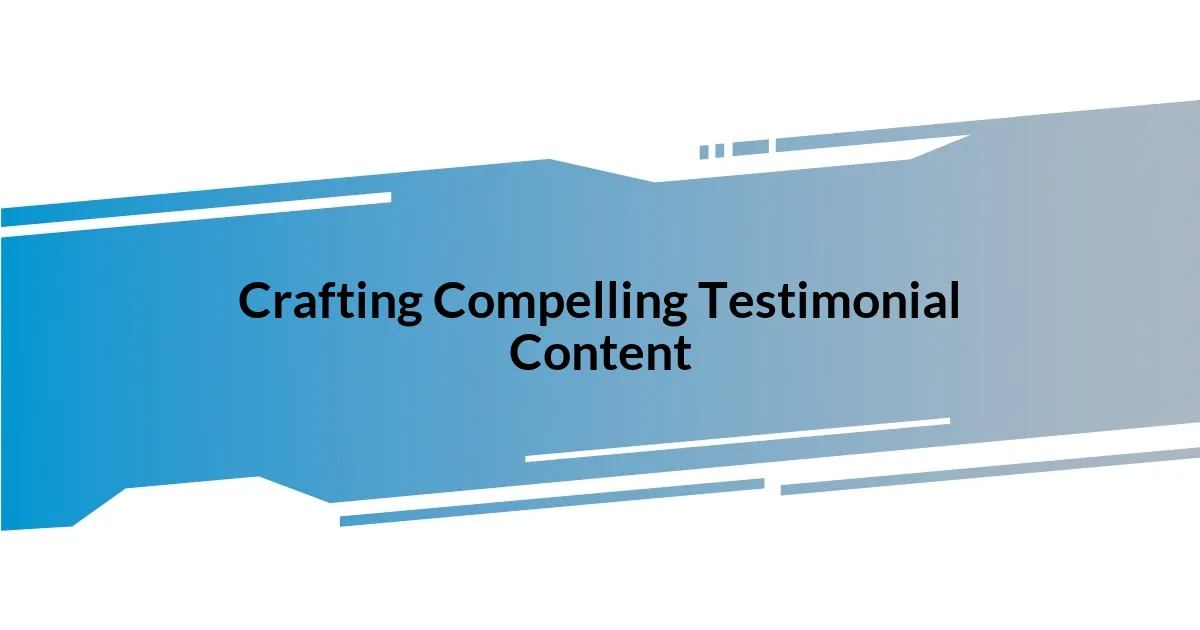Key takeaways:
- Testimonials serve as powerful validation and emotional connection, enhancing personal brands and trust with potential clients.
- Selecting relevant testimonials with specificity, relatability, and emotional weight can significantly improve audience engagement.
- Strategically placing testimonials in key areas, such as near calls-to-action or service descriptions, can increase client inquiries.
- Regularly updating testimonials and aligning them with current trends keeps your profile fresh and relevant, resonating more with potential clients.

Understanding the Power of Testimonials
Testimonials hold an untapped power that can be incredibly beneficial, especially for those of us trying to establish a personal brand. I remember when I first decided to showcase client feedback; it felt a bit daunting. But the moment I received my first heartfelt testimonial, something shifted. It wasn’t just words—it was validation of my efforts and impact, igniting a spark of confidence in my work.
Reflecting on different testimonials I’ve received, I’ve noticed a common thread of emotional connection. Customers share their stories, often revealing moments when my product or service truly made a difference in their lives. This not only encourages potential clients to trust me but also helps me understand the deeper impact of what I offer. Have you ever thought about how testimonials transform a simple service into a personal experience? They tell stories that resonate, creating a bridge between my work and the audience’s needs.
Moreover, highlighting these testimonials offers social proof that is hard to replicate. One instance stands out vividly: a client shared how my guidance changed her career trajectory. Her words made everything I do feel more purposeful. When potential clients read such anecdotes, they sometimes see their own challenges in those stories. This connection is profound, and it can be the defining factor in their decision-making process. So, don’t underestimate the emotional weight of a few well-placed testimonials; they can elevate your profile and resonate far beyond mere marketing.

Identifying the Right Testimonials
When it comes to selecting the right testimonials, I’ve learned that relevance is key. I once received a glowing review from a client who loved my services for personal branding. Her specific mention of how it helped her land her dream job resonated with potential clients in similar situations. It became a focal point in my promotional material, reinforcing the idea that my work can lead to transformative outcomes.
To identify valuable testimonials, consider these aspects:
- Specificity: Look for details that highlight particular results or benefits.
- Relatability: Choose testimonials from clients who represent your target audience.
- Emotional Connection: Highlight reviews that convey a strong emotional response.
- Credibility: Testimonials from recognizable figures or reputable clients can add weight.
- Diversity: Aim for a mix of testimonials that cover different aspects of your services or products.
Utilizing testimonials that reflect these characteristics has made a significant difference in how I connect with my audience. They tell a story that potential clients want to be part of, making them feel understood and inspired.

Crafting Compelling Testimonial Content
Crafting compelling testimonials isn’t just about gathering praise; it involves presenting the feedback in a way that resonates with your audience. For example, I once crafted a testimonial from a client whose transformation truly touched me. Instead of just stating she was satisfied, I highlighted her journey—from feeling overwhelmed and lost in her career to confidently pursuing her passions. This narrative drew readers in, sparking interest and encouraging them to envision their own potential growth with my services.
What I’ve found effective is using a blend of formats in presenting these testimonials. Written testimonials can be powerful, but I’ve also experimented with short video clips. A client once shared how working with me changed her perspective on public speaking; seeing her emotions firsthand added depth and relatability. It not only made the message more authentic but also connected with potential clients who share similar fears. Have you ever considered the impact of showcasing your testimonials in various formats? With each format, the goal is to evoke emotions and create a bond with your audience.
Moreover, context can enhance the power of testimonials significantly. I had a client who mentioned my support during a challenging project, emphasizing how my insights saved her team time and resources. By framing this testimony within the context of a specific challenge, I transformed a simple endorsement into a story of problem-solving. It invites others to think, “If she can help with that, what can she do for me?” Crafting testimonials with rich context invites dialogue and empowers potential clients to envision their own success.
| Elements of Compelling Testimonials | Examples |
|---|---|
| Emotional Stories | Client highlights overcoming personal challenges through my services. |
| Diverse Formats | Mix of written and video testimonials enhances engagement. |
| Contextual Relevance | Specific challenges addressed in testimonials draw in potential clients. |

Choosing Optimal Placement for Testimonials
Finding the right spots for testimonials on my profile has been a game changer. I’ve discovered that placing them near my call-to-action significantly boosts engagement. When potential clients see a testimonial that speaks directly to their needs right before they are encouraged to reach out, it creates a natural flow. It’s almost like having a friend vouch for you just before you make a decision to trust someone new.
I’ve also found that strategically positioning testimonials on service pages works wonders. For instance, I remember putting a powerful review about my coaching services right where I detailed the process. It felt seamless and inviting, showing real proof of the journey clients go through with me. This approach not only validates my offerings but also highlights the transformation that awaits them, creating a sense of anticipation. Does that resonate with you? It certainly did for my audience.
Another effective placement I’ve utilized is at the footer of my blog posts. After sharing valuable insights, I often include a couple of concise testimonials to remind readers what others have said about working with me. I’ve noticed that this method keeps their thoughts focused on the benefits while subtly encouraging them to take the next step. It’s all about weaving those affirmations throughout the experience, don’t you think? By placing testimonials where they feel like an integral part of the conversation, I’ve turned passive readers into active prospects.

Leveraging Testimonials on Social Media
Social media has become a dynamic platform for showcasing testimonials, and I’ve found it immensely effective for building my profile. By regularly posting snippets of client feedback paired with eye-catching visuals, I create an engaging narrative that draws my audience in. For instance, I once shared a heartfelt quote from a client about overcoming her fear of networking, accompanied by a candid photo of us together at an event. The response was overwhelming—people started commenting about their own similar fears, and it sparked a conversation that felt genuinely personal.
I’ve discovered that stories resonate deeply on platforms like Instagram or Facebook. Once, I recorded a series of short, Instagram Stories featuring clients sharing their experiences, and I was amazed by the engagement! By exposing the raw emotions behind success stories, I invited my followers to reflect on their own aspirations. Have you tried sharing client stories in a conversational format? It shifts the focus from me to my clients, making it feel less like advertising and more like meaningful storytelling.
Also, leveraging hashtags effectively can amplify the reach of these testimonials. I remember using specific hashtags related to my industry alongside a powerful testimonial post. It attracted not only my existing audience but also new potential clients interested in similar topics. Have you ever thought about how hashtags can connect you to a broader community? By tapping into these networks, I’ve not only raised my profile but also fostered a sense of collective belonging among those in similar journeys.

Monitoring the Impact of Testimonials
Monitoring the impact of my testimonials has been an eye-opening journey. I remember vividly when I first set up a simple feedback form to gather client responses after our sessions. Analyzing their feedback not only revealed what resonated most with them, but it also pinpointed the specific aspects of my coaching that led to their success. It was exciting to see patterns emerge—like the recurring themes of confidence and clarity—which I could then emphasize in my future marketing efforts. How often do we overlook the very voices that define our success?
I also began tracking metrics related to testimonials. For example, after starting to showcase client success stories, I noticed an uptick in inquiries about my services. Looking back, it was fascinating to see direct correlations between specific testimonials and increased engagement metrics. By utilizing tools like Google Analytics to assess traffic flow, I realized that testimonials could serve as powerful magnets, drawing in potential clients who may have otherwise passed by. It’s almost like connecting the dots; have you thought about how your testimonials might be guiding potential clients to your door?
Additionally, I made it a point to adjust my strategy based on the feedback received. After a few clients mentioned they felt inspired by stories of overcoming challenges, I prioritized highlighting those narratives in my outreach. This not only boosted my profile but created a sense of community among followers, resonating deeply with many who shared similar experiences. Monitoring testimonials isn’t just about tracking numbers; it’s about understanding and responding to the heartbeat of your audience. Have you ever stopped to listen to what your clients are truly saying? It might surprise you.

Continually Updating Your Testimonials
Keeping testimonials fresh is essential in staying relevant and engaging. I vividly recall the time I decided to update my testimonials quarterly, feeling that timely feedback would resonate more with potential clients. It turned out to be a game-changer; the new stories infused my profile with vibrant energy and demonstrated my ongoing commitment to client growth. Have you ever considered how fresh perspectives can breathe new life into your brand?
Occasionally reaching out to past clients for updated testimonials not only fosters goodwill but also offers insights into how your services have impacted their journey over time. I facilitated this by sending a simple, friendly email, and the response was heartwarming. One client shared how our work together had completely transformed her career trajectory. That emotional weight added a layer of authenticity that not only appealed to my audience but also reinforced my own motivation. Isn’t it incredible how those genuine moments of connection can echo through our marketing efforts?
Another practice I’ve embraced is highlighting recent testimonials that reflect current trends or challenges. I remember when remote work became mainstream; I reached out to clients who had navigated that transition successfully. Their stories struck a chord with a larger audience grappling with similar issues. It’s fascinating how aligning testimonials with contemporary themes can create a sense of urgency and relevance. How often do we connect our stories to the world around us? This practice not only enhances credibility but also builds a bridge between my work and the evolving landscape of my clients’ lives.
